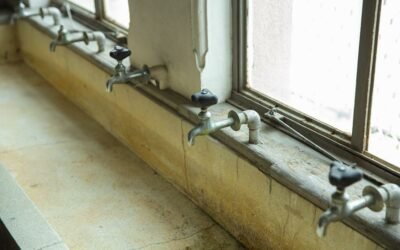Have you ever wondered if mold can cause strep throat? Well, the answer might surprise you.
In this article, we will explore the connection between mold and strep throat, and how it can affect your health. You'll learn about the symptoms of strep throat and the steps you can take to prevent mold growth in your environment.
So, let's dive in and uncover the truth about mold and its potential impact on your throat health.
Key Takeaways
- Mold exposure can weaken the immune system, making individuals more susceptible to bacterial infections.
- Limited scientific evidence directly links mold exposure to strep throat.
- Mold spores release mycotoxins that can irritate the respiratory system.
- Respiratory symptoms from mold exposure can potentially create an environment conducive to bacterial growth.
Understanding Mold and Its Effects
To understand the effects of mold, you should familiarize yourself with the various types and their potential health risks. Mold is a type of fungus that can grow indoors and outdoors. It thrives in warm, damp environments and can easily spread through the air. There are many different types of mold, but some common ones include Aspergillus, Cladosporium, and Stachybotrys. Each type of mold has its own characteristics and can cause different health problems.
Exposure to mold can lead to a range of health issues, including respiratory problems, allergies, and skin irritation. When mold spores are inhaled, they can trigger allergic reactions in some individuals. These reactions can include symptoms such as sneezing, coughing, wheezing, and a runny or stuffy nose. People with asthma or other respiratory conditions may experience more severe symptoms when exposed to mold.
In addition to respiratory problems, exposure to certain types of mold can also cause more serious health risks. Some molds produce mycotoxins, which are toxic substances that can have harmful effects on the body. Stachybotrys, also known as black mold, is one example of a mold that can produce mycotoxins. Prolonged exposure to these mycotoxins can lead to neurological symptoms, respiratory issues, and even immune system suppression.
To protect yourself from the potential health risks of mold, it's important to prevent its growth in your environment. This can be done by controlling moisture levels, fixing any water leaks or damage, and ensuring proper ventilation. If you suspect that you have a mold problem in your home, it's recommended to seek professional help for proper remediation.
The Symptoms of Strep Throat
If you have strep throat, you may experience a variety of symptoms. It's important to recognize these symptoms in order to seek appropriate medical treatment.
Here are some common signs of strep throat:
- Sore throat: One of the most noticeable symptoms of strep throat is a severe sore throat that makes it difficult to swallow. The pain may be accompanied by redness and swelling in the throat.
- Fever: Strep throat often causes a high fever, typically over 101°F (38.3°C). This fever may come on suddenly and can last for several days.
- Swollen lymph nodes: Strep throat can cause the lymph nodes in the neck to become tender and swollen. You may notice lumps or bumps on the sides of your neck.
- Other symptoms: In addition to the main symptoms mentioned above, strep throat can also cause headache, fatigue, and body aches. Some people may develop a rash or experience nausea and vomiting.
If you experience these symptoms, it's important to see a healthcare professional for a proper diagnosis and treatment. Strep throat is usually treated with antibiotics to help relieve symptoms and prevent complications.
Exploring the Connection Between Mold and Strep Throat
While mold exposure has been linked to various respiratory symptoms, it's important to explore whether there's a connection between mold and strep throat. Strep throat, also known as Streptococcal pharyngitis, is a bacterial infection caused by the Streptococcus pyogenes bacteria. It typically affects the throat and tonsils, causing symptoms such as sore throat, difficulty swallowing, and swollen lymph nodes.
Currently, there's limited scientific evidence to directly link mold exposure to the development of strep throat. Strep throat is primarily transmitted through respiratory droplets from an infected person or by touching surfaces contaminated with the bacteria. However, mold exposure can weaken the immune system, making individuals more susceptible to bacterial infections.
Mold spores release toxins known as mycotoxins, which can irritate the respiratory system and cause symptoms such as coughing, wheezing, and nasal congestion. These respiratory symptoms can potentially create an environment that's more conducive to the growth and spread of bacteria, including Streptococcus pyogenes.
To reduce the risk of mold-related respiratory symptoms and potential complications like strep throat, it's crucial to address any mold issues in your environment. This includes promptly repairing any water leaks, improving ventilation, and maintaining proper humidity levels. If you suspect mold exposure or are experiencing persistent respiratory symptoms, it's recommended to consult a healthcare professional for a proper diagnosis and treatment.
Preventing Mold Growth to Reduce the Risk of Strep Throat
To reduce the risk of strep throat, you can take measures to prevent the growth of mold in your environment. Mold can thrive in damp and humid conditions, so it's important to keep your surroundings clean and dry.
Here are some steps you can take to prevent mold growth:
- Control moisture levels:
- Use dehumidifiers to reduce humidity levels in your home.
- Fix any leaks or water damage promptly to prevent mold growth.
- Ensure proper ventilation in areas prone to moisture, such as bathrooms and kitchens.
- Keep your environment clean:
- Regularly clean and disinfect areas that are prone to mold growth, such as bathrooms and basements.
- Use mold-resistant paint and materials in areas where moisture is common.
- Clean and dry any wet or damp items, such as towels or clothes, to prevent mold growth.
- Improve air circulation:
- Use fans or open windows to improve air circulation and prevent moisture buildup.
- Avoid blocking air vents to allow proper airflow throughout your home.
Seeking Medical Treatment for Strep Throat
To seek medical treatment for strep throat, you should schedule an appointment with your healthcare provider. Strep throat is a bacterial infection caused by group A Streptococcus bacteria, and it requires proper medical attention for effective treatment.
When you visit your healthcare provider, they'll perform a physical examination and may also take a throat culture or rapid strep test to confirm the diagnosis. If the test results are positive, your healthcare provider will prescribe antibiotics, such as penicillin or amoxicillin, to help fight the infection. It's important to take the full course of antibiotics as prescribed, even if you start feeling better, to ensure complete eradication of the bacteria.
Alongside antibiotics, over-the-counter pain relievers like ibuprofen or acetaminophen can help alleviate symptoms such as throat pain and fever. It's crucial to rest, stay hydrated, and avoid contact with others to prevent the spread of the infection.
If your symptoms worsen or don't improve after a few days of starting treatment, you should contact your healthcare provider for further evaluation. Seeking timely medical treatment is essential to manage strep throat effectively and prevent complications.
Conclusion
In conclusion, while mold can cause various respiratory issues, there's no direct evidence linking it to strep throat. Strep throat is primarily caused by a bacterial infection and isn't typically associated with mold exposure.
However, it's important to address mold growth in order to maintain a healthy environment and prevent other respiratory issues.
If you suspect strep throat, it's advisable to seek medical treatment for a proper diagnosis and appropriate treatment.






0 Comments